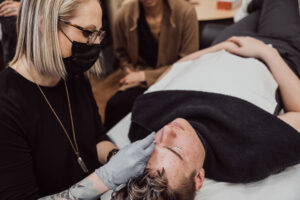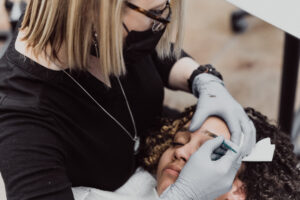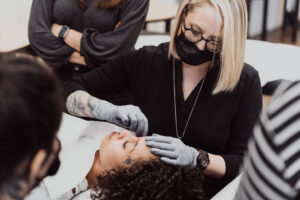Permanent Cosmetics: Enhancing Your Natural Beauty

In today’s fast-paced world, where time is of the essence, people are constantly seeking ways to simplify their daily routines. This desire for convenience and efficiency has led to the rise in popularity of permanent cosmetics. Imagine waking up each morning with perfectly defined eyebrows, flawless eyeliner, or beautifully colored lips. This dream can become a reality through the wonders of permanent cosmetics.
1. Introduction to Permanent Cosmetics
Permanent cosmetics, also known as micropigmentation or cosmetic tattooing, is a revolutionary beauty solution that involves depositing pigments into the dermal layer of the skin. Unlike traditional makeup that needs to be applied and reapplied daily, permanent cosmetics offer long-lasting results that can save you time and effort.
2. What is Permanent Cosmetics?
Permanent cosmetics is a technique that uses specialized pigments and tattooing methods to create long-lasting makeup effects. It involves depositing color into the skin to enhance features such as eyebrows, eyeliner, and lip color. The pigments used in permanent cosmetics are formulated to fade gradually over time, ensuring a natural look that can be adjusted as trends and personal preferences change.
 3. The History of Permanent Cosmetics
3. The History of Permanent Cosmetics
The concept of permanent cosmetics dates back thousands of years. Ancient civilizations, such as the Egyptians and Romans, used various techniques to enhance their facial features permanently. However, it was not until the late 20th century that modern permanent cosmetics techniques and equipment were developed, making the procedure safer and more precise.
4. How Permanent Cosmetics Works
Permanent cosmetics involve a meticulous process that requires the skill and expertise of a trained professional. The procedure typically begins with a consultation to discuss your desired results and design. Then, a handheld device or tattooing machine is used to implant pigments into the skin, creating the desired makeup effect. The depth of pigment placement is carefully controlled to ensure a natural appearance.
5. Benefits of Permanent Cosmetics
Enhances Natural Features
One of the significant benefits of permanent cosmetics is its ability to enhance and define your natural features. Whether you desire fuller eyebrows, more pronounced eyeliner, or a hint of color on your lips, permanent cosmetics can help you achieve your desired look while still maintaining a natural appearance.
 Saves Time and Effort
Saves Time and Effort
With permanent cosmetics, you can say goodbye to the daily ritual of applying and removing makeup. Imagine the extra time you’ll have in the mornings when you no longer need to worry about perfecting your eyeliner or filling in your eyebrows. Permanent cosmetics offer a time-saving solution for those with busy lifestyles.
Boosts Self-Confidence
Having well-defined and symmetrical features can significantly boost your self-confidence. Permanent cosmetics can help correct asymmetry, sparse brows, or thin lips, giving you a sense of self-assurance and allowing you to feel more comfortable and beautiful in your own skin.
Helps with Medical Conditions
Permanent cosmetics can be a game-changer for individuals with medical conditions such as alopecia or vitiligo. The procedure can create realistic-looking eyebrows or camouflage skin discolorations, providing a sense of normalcy and boosting self-esteem.
6. Different Types of Permanent Cosmetics
Permanent cosmetics cover a wide range of makeup applications. Some popular options include:
 Permanent Eyebrows
Permanent Eyebrows
Permanent eyebrows can be tailored to your desired shape and color, creating a more defined and symmetrical appearance. Whether you prefer a natural-looking brow or a more dramatic arch, a skilled permanent cosmetics artist can design and implant the perfect eyebrows for you.
Permanent Eyeliner
Permanent eyeliner can enhance the shape and definition of your eyes, making them appear more vibrant and awake. From a subtle lash enhancement to a bold winged liner, permanent eyeliner can save you time and effort while accentuating your natural beauty.
Permanent Lip Color
Say goodbye to smudged lipstick and constant touch-ups with permanent lip color. Whether you desire a soft pink hue or a vibrant red pout, permanent lip color can provide long-lasting color and definition to your lips.
Permanent Makeup Corrections
If you’ve had previous permanent cosmetics that didn’t turn out as expected, don’t worry. Skilled permanent cosmetics artists can correct and improve existing work, ensuring that you leave their studio with the desired results.
7. The Procedure of Getting Permanent Cosmetics
The process of getting permanent cosmetics involves several steps to ensure a safe and satisfactory outcome. These steps typically include:
Consultation and Design
Before the procedure, you will have a consultation with the permanent cosmetics artist. During this session, you can discuss your desired results, preferences, and any concerns you may have. The artist will analyze your facial features and design a customized look that suits you.
Pigmentation Process
Once the design is finalized, the pigmentation process begins. The artist will use sterile needles and a tattooing device to deposit the pigments into the dermal layer of your skin. The procedure may require multiple sessions, depending on the desired intensity and the area being treated.
Aftercare and Healing
Proper aftercare is crucial for the healing and longevity of your permanent cosmetics. The artist will provide detailed instructions on how to care for the treated area, including the use of ointments, avoiding excessive moisture, and protecting the area from sun exposure. It’s important to follow these instructions to ensure optimal healing and color retention.
8. Choosing a Permanent Cosmetics Artist
When considering permanent cosmetics, it’s essential to choose a skilled and reputable artist. Here are some factors to consider when selecting an artist:
Research and Recommendations
Start by researching local artists and reading reviews from their clients. Seek recommendations from friends or family members who have had successful permanent cosmetics procedures.
Portfolio and Qualifications
Review the artist’s portfolio to assess their skills and expertise. Look for before and after photos that demonstrate their ability to create natural-looking results. Additionally, ensure that the artist has the necessary certifications and qualifications.
Safety and Sterilization Practices
Your safety should be a top priority. Inquire about the artist’s sterilization practices and ensure that they follow strict hygiene protocols. They should use single-use, disposable needles and adhere to the highest standards of cleanliness.
9. Risks and Considerations of Permanent Cosmetics
While permanent cosmetics offer numerous benefits, it’s important to be aware of the potential risks and considerations. These may include:
Allergic Reactions
Some individuals may experience allergic reactions to the pigments used in permanent cosmetics. It’s crucial to undergo a patch test before the procedure to identify any allergies or sensitivities.
Infections
Improper sterilization or poor hygiene practices can lead to infections. It’s essential to choose an artist who follows strict sterilization protocols and maintains a clean working environment.
Fading and Color Changes
Over time, the pigments used in permanent cosmetics can fade or undergo color changes. Exposure to sunlight, certain skincare products, and individual factors can contribute to these changes. Regular touch-ups are often necessary to maintain the desired appearance.
10. Aftercare Tips for Maintaining Permanent Cosmetics
To ensure the longevity and vibrancy of your permanent cosmetics, follow these aftercare tips:
Proper Cleansing and Moisturizing
Cleanse the treated area gently with mild, non-abrasive cleansers. Avoid scrubbing or rubbing the area excessively. After cleansing, apply a recommended moisturizer to keep the skin hydrated and prevent dryness.
Sun Protection
Protect your permanent cosmetics from sun exposure by applying sunscreen with a high SPF. UV rays can cause the pigments to fade more quickly, leading to the need for more frequent touch-ups.
Avoiding Harsh Chemicals
Avoid using skincare products that contain harsh chemicals or exfoliants on the treated area. These can cause irritation and interfere with the pigments’ longevity.
11. Frequently Asked Questions (FAQs)

1. Is permanent cosmetics painful?
The level of discomfort experienced during the procedure varies from person to person. Most individuals report minimal discomfort, which can be alleviated with the use of topical numbing creams.
2. How long does permanent cosmetics last?
The longevity of permanent cosmetics varies depending on several factors, including the pigments used, individual skin characteristics, and lifestyle. On average, the effects can last between two to five years before requiring touch-ups.
3. Can permanent cosmetics be removed?
While permanent cosmetics are designed to be long-lasting, they can be modified or removed. Laser tattoo removal is a common method used to fade or eliminate unwanted permanent cosmetics.
4. Is it safe to get permanent cosmetics?
When performed by a trained and experienced professional, permanent cosmetics are generally safe. However, it’s important to ensure that the artist follows strict sterilization practices and uses high-quality pigments.
5. What should I expect during the healing process?
During the healing process, it’s normal to experience some redness, swelling, and minor scabbing. The treated area may appear darker initially but will lighten as it heals. It’s essential to follow the aftercare instructions provided by your artist to promote proper healing.
6. Can permanent cosmetics fade over time?
Yes, permanent cosmetics can fade over time due to factors such as sun exposure, skincare products, and individual skin characteristics. Regular touch-ups are recommended to maintain the desired appearance.
7. Are there any side effects of permanent cosmetics?
While side effects are rare, some individuals may experience temporary redness, swelling, or minor discomfort during the healing process. Allergic reactions and infections are also possible but can be minimized by choosing a skilled and reputable artist.
8. Can I still wear traditional makeup with permanent cosmetics?
Yes, you can still wear traditional makeup over your permanent cosmetics if desired. However, many individuals find that they require less traditional makeup after getting permanent cosmetics.
9. How long does the permanent cosmetics procedure take?
The duration of the procedure varies depending on the area being treated and the desired results. Generally, it can take anywhere from one to three hours to complete the initial session.
10. Can I swim or engage in physical activities after getting permanent cosmetics?
It’s advisable to avoid swimming, saunas, hot tubs, and intense physical activities for at least one week after getting permanent cosmetics. This allows the treated area to heal properly and reduces the risk of infection or pigment loss.
Permanent cosmetics offer a convenient and long-lasting solution for enhancing your natural beauty. Whether you desire perfectly shaped eyebrows, defined eyeliner, or a touch of color on your lips, permanent cosmetics can save you time and effort while boosting your self-confidence. By choosing a skilled artist, understanding the risks and considerations, and following proper aftercare, you can enjoy the benefits of permanent cosmetics for years to come.

